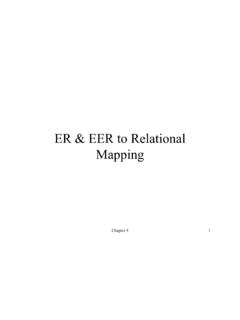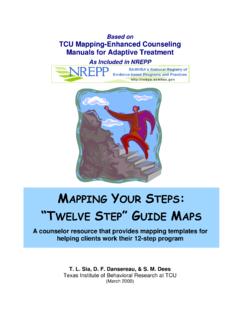Transcription of PDPM Calculation Worksheet for SNFs - Centers for Medicare ...
1 PDPM Calculation Worksheet for SNFs 1 In the PDPM, there are five case-mix adjusted components: PT, OT, SLP, NTA, and Nursing. Each patient is to be classified into one and only one group for each of the five case-mix adjusted components. In other words, each patient is classified into a PT group, an OT group, an SLP group, an NTA group, and a nursing group. For each of the case-mix adjusted components, there are a number of groups to which a patient may be assigned, based on the relevant MDS data for that component. There are 16 PT groups, 16 OT groups, 12 SLP groups, 6 NTA groups, and 25 nursing groups.
2 PDPM classifies patients into a separate group for each of the case-mix adjusted components, each of which have their own associated case-mix indexes and base rates. Additionally, PDPM applies variable per diem payment adjustments to three components, PT, OT, and NTA, to account for changes in resource use over a stay. The adjusted PT, OT, and NTA per diem rates are then added together with the unadjusted SLP and nursing component rates and the non-case-mix component to determine the full per diem rate for a given patient. PDPM Calculation Worksheet for SNFs 2 Calculation of PDPM Cognitive Level The PDPM cognitive level is utilized in the SLP payment component of PDPM.
3 One of four PDPM cognitive performance levels is assigned based on the Brief Interview for Mental Status (BIMS) or the Staff Assessment for Mental Status for the PDPM cognitive level. If neither the BIMS nor the staff assessment for the PDPM cognitive level is complete, then the PDPM cognitive level cannot be assigned and the PDPM case mix group cannot be determined. STEP #1 Determine the patient s BIMS Summary Score on the MDS based on the patient interview. Instructions for completing the BIMS are in Chapter 3, Section C. The BIMS involves the following items: C0200 Repetition of three words C0300 Temporal orientation C0400 Recall Item C0500 provides a BIMS Summary Score that ranges from 00 to 15.
4 If the patient interview is not successful, then the BIMS Summary Score will equal 99. Calculate the patient s PDPM cognitive level using the following mapping : Table 1: Calculation of PDPM Level from BIMS PDPM Cognitive Level BIMS Score Cognitively Intact 13-15 Mildly Impaired 8-12 Moderately Impaired 0-7 Severely Impaired - PDPM Cognitive Level:If the patient s Summary Score is 99 (patient interview not successful) or the Summary Score is blank (patient interview not attempted and skipped) or the Summary Score has a dash value (not assessed), then proceed to Step #2 to use the Staff Assessment for Mental Status for the PDPM cognitive level.
5 PDPM Calculation Worksheet for SNFs 3 STEP #2 If the patient s Summary Score is 99 or the Summary Score is blank or has a dash value, then determine the patient s cognitive status based on the Staff Assessment for Mental Status for the PDPM cognitive level using the following steps: A) The patient classifies as severely impaired if one of following conditions exist: a. Comatose (B0100 = 1) and completely dependent or activity did not occur at admission (GG0130A1, GG0130C1, GG0170B1, GG0170C1, GG0170D1, GG0170E1, and GG0170F1, all equal 01, 09, or 88). b. Severely impaired cognitive skills for daily decision making (C1000 = 3).
6 B) If the patient is not severely impaired based on Step A , then determine the patient s Basic Impairment Count and Severe Impairment Count. For each of the conditions below that applies, add one to the Basic Impairment Count. a. In Cognitive Skills for Daily Decision Making, the patient has modified independence or is moderately impaired (C1000 = 1 or 2). b. In Makes Self Understood, the patient is usually understood, sometimes understood, or rarely/never understood (B0700 = 1, 2, or 3). c. Based on the Staff Assessment for Mental Status, patient has memory problem (C0700 = 1). Sum a.
7 , b., and c. to get the Basic Impairment Count: ____ For each of the conditions below that applies, add one to the Severe Impairment Count. a. In Cognitive Skills for Daily Decision Making, patient is moderately impaired (C1000 = 2). b. In Makes Self Understood, patient is sometimes understood or rarely/never understood (B0700 = 2 or 3). Sum a. and b. to get the Severe Impairment Count: ____ C) The patient classifies as moderately impaired if the Severe Impairment Count is 1 or 2 and the Basic Impairment Count is 2 or 3. D) The patient classifies as mildly impaired if the Basic Impairment Count is 1 and the Severe Impairment Count is 0, 1, or 2, or if the Basic Impairment Count is 2 or 3 and the Severe Impairment Count is 0.
8 E) The patient classifies as cognitively intact if both the Severe Impairment Count and Basic Impairment Count are 0. PDPM Cognitive Level: PDPM Calculation Worksheet for SNFs 4 Payment Component: PT STEP #1 Determine the patient s primary diagnosis clinical category using the ICD-10-CM code recorded in MDS item I0020B. To do so, refer to the PDPM Clinical Categories to ICD-10 Diagnosis Codes mapping (available at Payment/ ), which maps a patient s primary diagnosis as recorded in MDS item I0020B to the 10 PDPM primary diagnosis clinical categories. I0020B diagnosis: Default primary diagnosis clinical category: Some ICD-10-CM codes can map to a different clinical category from the default depending on a patient s prior inpatient procedure history.
9 For these codes, a patient may be categorized into a surgical clinical category if the patient received a surgical procedure during the prior inpatient stay that relates to the primary reason for the Part A SNF stay as indicated by item J2100. If the PDPM clinical category mapping indicates that the patient s primary diagnosis code is eligible for one of the two orthopedic surgery categories (major joint replacement or spinal surgery, and orthopedic surgery (except major joint replacement or spinal surgery)) then proceed to Step 1A; if eligible for the non-orthopedic surgery category, then proceed to Step 1C.
10 Otherwise, proceed to Step 1D to finalize the primary diagnosis clinical category assignment. STEP #1A Determine whether the patient received a major joint replacement or spinal surgery during the prior inpatient stay using item J2100. If any of the procedures indicated in items J2300, J2310, J2320, J2330, J2400, J2410, or J2420 was performed during the prior inpatient stay, then the patient is categorized into the major joint replacement or spinal surgery clinical category. If none of these procedures was performed, the patient did not receive major joint replacement or spinal surgery during the prior inpatient stay for purposes of determining the PDPM classification.














